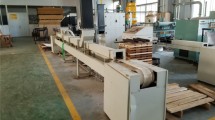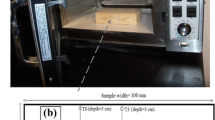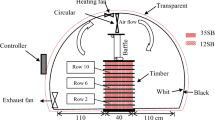Abstract
Microwave is a useful and proven tool for increasing permeability of refractory wood and, thereby, it can be used for reducing drying time and defects. However, strength loss is always a concern. In this study, green timber boards were treated with microwave in two intensities, low microwave (LMW), 89 kWh/m3, and high microwave (HMW), 95 kWh/m3, and compared with control boards. Samples of all three treatments were kiln dried together. Density and selected mechanical properties were also assessed after drying. LMW, the treatment which presented the best results, showed reduction in some drying defects, such as collapse (20%), surface check length (84%), internal check length (50%) and internal check width (70%). Density, MOE and MOR on static bending were unchanged, whereas reductions in shear strength (13%) and compression strength parallel to grain (10%) were observed. HMW, on the other hand, produced higher strength reductions and more drying defects than LMW. Fine adjustments of LMW microwave power might bring drying benefits without strength losses.











Similar content being viewed by others
References
American Society for Testing and Materials (2009) ASTM D143—standard test methods for small clear specimens of timber. ASTM International, West Conshohocken, PA
Arshanitsa A, Dizhbite T, Bikovens O, Pavlovich G, Andersone A, Telysheva G (2016) Effects of microwave treatment on the chemical structure of lignocarbohydrate matrix of softwood and hardwood. Energy Fuels 30(1):457–464
Bergman R (2010) Drying and control of moisture content and dimensional changes. In: Forest Products Laboratory (2010) Wood handbook—wood as an engineering material. General technical report FPL-GTR-190. Madison, WI: U.S. Department of Agriculture, Forest Service, Forest Products Laboratory
Brodie G (2006) Microwave treatment accelerates solar timber drying, 2006 ASABE annual international meeting, pp 1–11
Chafe SC, Barnacle JE, Hunter AJ, Ilic J, Northway RL, Rozsa AN (1992) Collapse: an introduction. CSIRO Division of Forest Products, Melbourne
Compere AL (2005) High-speed microwave treatment for rapid wood drying. Quarterly Status Report 24. Office of Industrial Technologies, US Department of Energy, Washington, DC, pp 229–236
Gere JM, Goodno BJ (2008) Mechanics of materials, 6th. edn. Thomson Learning, Belmont
Hansson L, Antti AL (2003) The effect of microwave drying on Norway spruce woods strength: a comparison with conventional drying. J Mater Process Technol 141:41–50
Harris GA, Torgovnikov G, Vinden P, Brodie GI, Shaginov A (2008) Microwave pretreatment of backsawn messmate boards to improve drying quality: part 1. Drying Technol 26(5):579–584
He Q, Wang X (2015) Drying stress relaxation of wood subjected to microwave radiation. BioResources 10(3):4441–4452
He X, Xiong X, Xie J, Li Y, Wei Y, Quan P (2017) Effect of microwave pretreatment on permeability and drying properties of wood. BioResources 12(2):3850–3863
Keey RB, Langrish TAG, Walker JCF (2000) Kiln-drying of lumber. Springer, Berlin
Koiš V, Dömény J, Tippner J (2014) Microwave device for continuous modification of wood. BioResources 9(2):3025–3037
Oloyede A, Groombridge P (2000) The influence of microwave heating on the mechanical properties of wood. J Mater Process Technol 100(1–3):67–73
Pratt GH, Coday AE, Maun KW (2010) Timber Drying Manual. Third Edition. IHS BRE Press, Bracknell
R Development Core Team (2016) “R: a language and environment for statistical computing”. R Foundation for Statistical Computing, Vienna. http://www.r-project.org/. Accessed 21 July 2016
Rasband WS (1997–2011) ImageJ. U.S. National Institute of Health, Bethesda, Maryland. http://imagej.nih.gov/ij/. Accessed 14 Mar 2014
Singh AP, Schmitt U, Dawson BSW, Rickard C (2009) Biomodification of radiata pine to enhance penetrability. New Zealand J Forest Sci 39:145–151
Singh AP, Kim YS, Singh T (2016) Chap. 9 - Bacterial degradation of wood. In: Kim YS, Funada R, Singh AP Secondary xylem biology. Academic Press, Boston, pp 169–190
Taghiyari HR (2013) Effects of heat-treatment on permeability of untreated and nanosilver-impregnated native hardwoods. Maderas Ciencia y Tecnología 15(2):183–194
Tanaka T, Avramidis S, Shida S (2010) A preliminary study on ultrasonic treatment effect on transverse wood permeability. Maderas Ciencia y Tecnología 12(1):3–9
Torgovnikov G, Vinden P (2009) High-intensity microwave wood modification for increasing permeability. Forest Prod J 59(4):84–92
Torgovnikov G, Vinden P (2010) Microwave wood modification technology and its applications. Forest Prod J 60(2):173–182
Torgovnikov G, Harris G, Vinden P (2013) Microwave hardwood modification technology for fast timber drying. Conference paper. September 16–19, Nottingham, UK. In: Proceedings 14th International Conference on microwave and high frequency heating, pp. 108–111
Torgovnikov G, Vinden P, Balboni BM (2015) Microwave conversion of plantation grown blue gum (Eucalyptus glubulues L’Herit) wood to Torgvin and impregnation with a metal alloy. J Mater Sci Eng Adv Technol 11(1):1–19
Vermaas HF (1995) Drying eucalypts for quality: material characteristics, pre-drying treatments, drying methods, schedules and optimization of drying quality. Suid-Afrikaanse Bosboutydskrif, Pretoria n. 174:41–49
Wallis NK (1970) Australian timber handbook, 3rd edn. Angus and Robertson, Sydney
Waterson GC (1997) Australian timber seasoning manual. Australasian Furnishing Research & Development Institute Ltd, Launceston
Yau C (2013) R tutorial with Bayesian statistics using OpenBUGS. E-book. Palo Alto: Chi Yau. http://www.r-tutor.com/content/r-tutorial-ebook. Accessed 14 Nov 2014
Yin L, Singh P, Brodie G, Sheehan M, Jacob MV (2013) Experimental and simulation approaches: effect of microwave energy on mechanical strength in sugarcane. Aust J Multi Discip Eng 10(2):120–128
Acknowledgements
This study was supported by The University of São Paulo and The University of Melbourne. The authors also acknowledge great contributions provided during wood drying experiments by Mr. Rob Rule and his team at the Timber Training Centre Creswick and Mr. Gerry Harris, School of Ecosystem and Forest Sciences, The University of Melbourne, for suggestions made during the project planning.
Author information
Authors and Affiliations
Corresponding author
Rights and permissions
About this article
Cite this article
Balboni, B.M., Ozarska, B., Garcia, J.N. et al. Microwave treatment of Eucalyptus macrorhyncha timber for reducing drying defects and its impact on physical and mechanical wood properties. Eur. J. Wood Prod. 76, 861–870 (2018). https://doi.org/10.1007/s00107-017-1260-1
Received:
Published:
Issue Date:
DOI: https://doi.org/10.1007/s00107-017-1260-1




